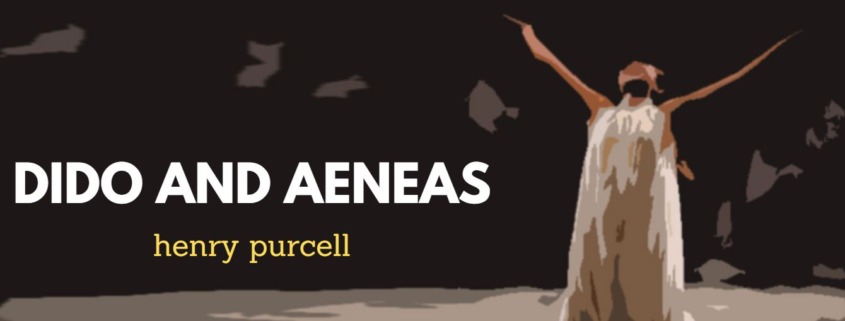WHEN I AM LAID IN EARTH – an Aria from “Dido and Aeneas”
The opera guide of Henry Purcell’s aria WHEN I AM LAID IN EARTH
Read interesting facts and listen to great YouTube videos of Purcell’s famous aria “WHEN I AM LAID IN EARTH”.
The aria WHEN I AM LAID IN EARTH – Synopsis and background
Synopsis: Dido, the queen of Carthage has fallen in love with Aeneas, the prince of the arch-enemy from Troy, whom her troops have rescued shipwrecked from the sea. In order to bring the two hostile kingdoms together, Dido decided to marry Aeneas, although she still mourns her husband, who had recently died in the Trojan battle. She falls in love with Aeneas.
But dark forces of sorcerers and witches oppose this union. They make a spirit appear to Aeneas, who asks him in the name of Jupiter to set sail and leave Carthage. Aeneas is heartbroken and explains the mission and his decision to Dido with a heavy heart. When he realizes her pain, he decides not to follow the order.
But Dido is no longer interested. The mere fact that Aeneas has thought of leaving her is reason enough for her to break off her love.
Dido only wants to die. She turns to her sister Belinda, only to die by her own hand.
This piece is one of the great arias of opera literature, a lamento, a classic product of baroque opera. It is uncommonly effectively written and belongs to the handful of baroque lamentos that can truly move the listener to tears.
Purcell wrote this piece immensely effectively. He begins with a downward chromatic motif in the bass accompaniment that becomes a deep sad ground bass (basso ostinato) and a constantly repeated motif:
At the end of the ostinato, Dido enters with her lament:
This melody captivates with many great effects. Particularly impressive: in contrast to the downward ostinato of the accompanying voice, Dido’s melody strives upward with leaps (and subsequent downward notes) from the g at “when” to the e at “no”, which makes Dido’s discord visible. Also contributing to the somber mood is the beautiful appoggiatura on the first “laid” (an added dissonance, foreign to the melody, that occurs on the stressed part of the measure and is resolved on the next note). We find another beautiful effect of the voice in the above note example in the somber tritone on “Trouble”
In the second part, Purcell introduces another element in the vocal part, the “Remember me”, enchanting by its simplicity:
With the last “Remember me” Purcell lets the music float into comforting heights, before it goes into the depths of despair with “forget my fate” at the end.
The aria – the text of WHEN I AM LAID IN EARTH
When I am laid in earth,
May my wrongs create
No trouble in thy breast;
Remember me, but ah! forget my fate.
Great Interpretations of WHEN I AM LAID IN EARTH
You will hear this aria in 7 different versions
Perhaps the bleakest and thus most moving recording is by Janet Baker. She sings the aria in a stifled voice that opens only with the last bars, creating a great effect.
When I am laid in earth – Baker
With her rich voice we hear Leontyne Price’s gospel-like, powerful dirge.
When I am laid in earth – Price
A few months before her recording of “Dido,” Kirsten Flagstadt was allowed, at Richard Strauss’ request, to premiere his swan song “Four Last Songs” in 1950. Her interpretation of Dido’s lament has majestic grandeur and is accompanied by expressive cellos.
When I am laid in earth – Flagstadt
A recent recording by Sarah Conolly with a tragic interpretation.
When I am laid in earth – Conolly
German countertenor Andreas Scholl’s interpretation has an inconsolable, cutting pain in his voice.
When I am laid in earth – Scholl
A “modern” interpretation of the English punk singer Alyson Moyet, sung in the low vocal register.
When I am laid in earth – Moyet
A recording that expresses the pain through the transience of beauty.
When I am laid in earth – Norman
A haunting interpretation by Klaus Nomi (1944-1983), a countertenor who also sang pop music.
When I am laid in earth – Nomi
Peter Lutz, opera-inside, the online opera guide to the aria “WHEN I AM LAID IN EARTH” from the opera “Dido and Aeneas” by Henry Purcell








You forgot to mention the absolutely stunning rendition by the late Jeff Buckley.
Here is a link to the article that describes his unexpected contribution to Elvis Costello’s Meltdown Festival in 1995, including that gut-wrenching solo.
https://philipsheppard.com/2009/02/10/playing-with-jeff-buckley/